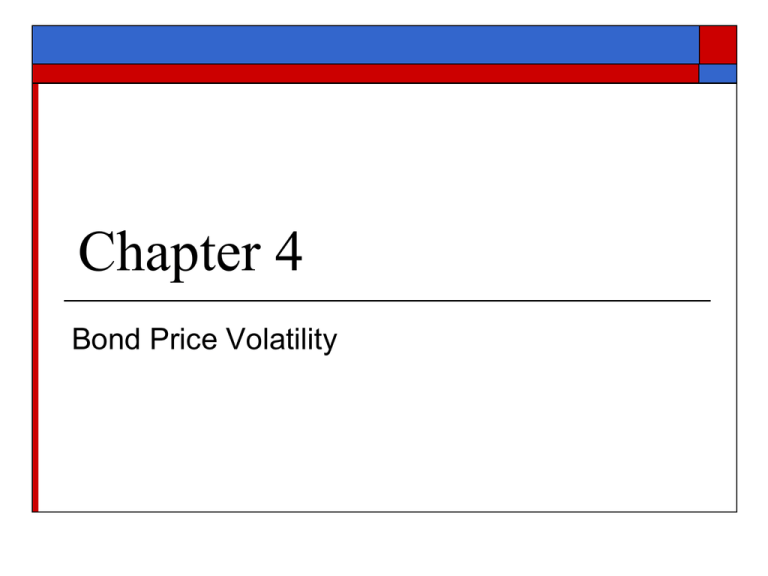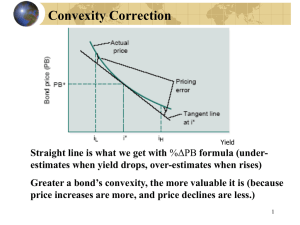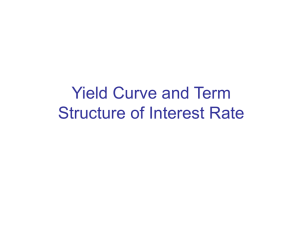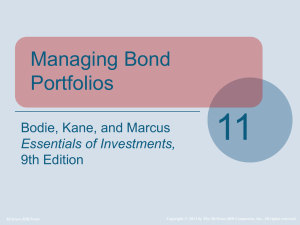Chapter 4
advertisement

Chapter 4 Bond Price Volatility Introduction Bond volatility is a result of interest rate volatility: When interest rates go up bond prices go down and vice versa. Goals of the chapter: To understand a bond’s price volatility characteristics. Quantify price volatility. Price-Yield Relationship - Maturity Consider two 9% coupon semiannual pay bonds: Bond A: 5 years to maturity. Bond B: 25 years to maturity. Yield 5 Years 25 Years 6 1,127.95 1,385.95 7 1,083.17 1,234.56 8 1,040.55 1,107.41 9 1,000.00 1,000.00 10 961.39 908.72 11 924.62 830.68 12 889.60 763.57 The long-term bond price is more sensitive to interest rate changes than the short-term bond price. Price-Yield Relationship - Coupon Rate Consider three 25 year semiannual pay bonds: 9%, 6%, and 0% coupon bonds Notice what happens as yields increase from 6% to 12%: Yield 9% 6% 0% 9% 6% 0% 6% 1,127.95 1,000.00 228.11 0% 0% 0% 7% 1,083.17 882.72 179.05 -4% -12% -22% 8% 1,040.55 785.18 140.71 -8% -21% -38% 9% 1,000.00 703.57 110.71 -11% -30% -51% 10% 961.39 634.88 87.20 -15% -37% -62% 11% 924.62 576.71 68.77 -18% -42% -70% 12% 889.60 527.14 54.29 -21% -47% -76% Bond Characteristics That Influence Price Volatility Maturity: For a given coupon rate and yield, bonds with longer maturity exhibit greater price volatility when interest rates change. Why? Coupon Rate: For a given maturity and yield, bonds with lower coupon rates exhibit greater price volatility when interest rates change. Shape of the Price-Yield Curve If we were to graph price-yield changes for bonds we would get something like this: Price What do you notice about this graph? Yield It isn’t linear…it is convex. It looks like there is more “upside” than “downside” for a given change in yield. Price Volatility Properties of Bonds Properties of option-free bonds: All bond prices move opposite direction of yields, but the percentage price change is different for each bond, depending on maturity and coupon For very small changes in yield, the percentage price change for a given bond is roughly the same whether yields increase or decrease. For large changes in yield, the percentage price increase is greater than a price decrease, for a given yield change. Price Volatility Properties of Bonds Exhibit 4-3 from Fabozzi text, p. 61 (required yield is 9%): Measures of Bond Price Volatility Three measures are commonly used in practice: 1. Price value of a basis point (also called dollar value of an 01) 2. Yield value of a price change 3. Duration Price Value of a Basis Point The change in the price of a bond if the required yield changes by 1bp. Recall that small changes in yield produce a similar price change regardless of whether yields increase or decrease. Therefore, the Price Value of a Basis Point is the same for yield increases and decreases. Price Value of a Basis Point We examine the price of six bonds assuming yields are 9%. We then assume 1 bp increase in yields (to 9.01%) Bond Initial Price New Price (at 9% yield) (at 9.01%) Price Value of a BP 5-year, 9% coupon 100.0000 99.9604 0.0396 25-year, 9% coupon 100.0000 99.9013 0.0987 5-year, 6% coupon 88.1309 88.0945 0.0364 25-year, 6% coupon 70.3570 70.2824 0.0746 5-year, 0% coupon 64.3928 64.362 0.0308 25-year, 0% coupon 11.0710 11.0445 0.0265 Yield Value of a Price Change Procedure: Calculate YTM. Reduce the bond price by X dollars. Calculate the new YTM. The difference between the YTMnew and YTMold is the yield value of an X dollar price change. Duration The concept of duration is based on the slope of the price-yield relationship: What does slope of a curve tell us? Price Yield How much the y-axis changes for a small change in the x-axis. Slope = dP/dy Duration—tells us how much bond price changes for a given change in yield. Note: there are different types of duration. Two Types of Duration Modified duration: Dollar duration: Tells us how much a bond’s price changes (in percent) for a given change in yield. Tells us how much a bond’s price changes (in dollars) for a given change in yield. We will start with modified duration. Deriving Duration The price of an option-free bond is: P C C C 2 3 (1 y ) (1 y ) (1 y ) C M (1 y ) n (1 y ) n P = bond’s price C = semiannual coupon payment M = maturity value (Note: we will assume M = $100) n = number of semiannual payments (#years 2). y = one-half the required yield How do we get dP/dy? Duration, con’t The first derivative of bond price (P) with respect to yield (y) is: dP 1 C 2C 2 dy 1 y (1 y) (1 y) nC nM (1 y)n (1 y) n This tells us the approximate dollar price change of the bond for a small change in yield. To determine the percentage price change in a bond for a given change in yield we need: dP 1 1 1 C 2C 2 dy P 1 y P (1 y ) (1 y ) nC nM n (1 y ) (1 y )n Macaulay Duration Duration, con’t Therefore we get: Modified Duration Macaulay Duration 1 y Modified duration gives us a bond’s approximate percentage price change for a small (100bp) change in yield. Duration is measured on a per period basis. For semi-annual cash flows, we adjust the duration to an annual figure by dividing by 2: Duration in years Duration over a single period 2 Calculating Duration Recall that the price of a bond can be expressed as: 1 1 (1 y ) n PC y M n (1 y ) Taking the first derivative of P with respect to y and multiplying by 1/P we get: C 2 y Modified Duration 1 n( M C / y ) 1 (1 y)n (1 y)n1 P Example Consider a 25-year 6% coupon bond selling at 70.357 (par value is $100) and priced to yield 9%. C 1 n( M C / y ) 1 2 n n 1 y (1 y ) (1 y ) Modified Duration P 3 2 0.045 Modified Duration 50(100 3 / 0.045) 1 1 (1.045)50 51 (1.045) 70.357 Modified Duration 21.23508 (in number of semiannual periods) To get modified duration in years we divide by 2: Modified Duration 10.62 Duration duration is less than (coupon bond) or equal to (zero coupon bond) the term to maturity all else equal, the lower the coupon, the larger the duration the longer the maturity, the larger the duration the lower the yield, the larger the duration the longer the duration, the greater the price volatility Properties of Duration Macaulay Duration Modified Duration 5-year 4.13 3.96 9% 25-year 10.33 9.88 5-year 4.35 4.16 6% 25-year 11.10 10.62 5-year 5.00 4.78 0% 25-year 25.00 23.98 Bond 9% 6% 0% Duration and Maturity: Duration increases with maturity. Duration and Coupon: The lower the coupon the greater the duration. Earlier we showed that holding all else constant: The longer the maturity the greater the bond’s price volatility (duration). The lower the coupon the greater the bond’s price volatility (duration). Properties of Duration, con’t What is the relationship between duration and yield? Yield Modified The lower the yield the higher the (%) Duration duration. 7 11.21 Therefore, the lower the yield the 8 10.53 higher the bond’s price volatility. 9 9.88 10 9.27 11 8.7 12 8.16 13 7.66 14 7.21 Approximating Dollar Price Changes How do we measure dollar price changes for a given change in yield? We use dollar duration: approximate price change for 100 bp change in yield. Recall: Solve for dP/dy: dP 1 = - modified duration dy P dP (modified duration)P dy dollar _ duration Solve for dP: dP (dollar duration)dy Example of Dollar Duration A 6% 25-year bond priced to yield 9% at 70.3570. Dollar duration = 747.2009 What happens to bond price if yield increases by 100 bp? dP (dollar duration)dy dP (747.2009) 0.01 dP $7.47 A 100 bp increase in yield reduces the bond’s price by $7.47 dollars (per $100 in par value) This is a symmetric measurement. Example, con’t Suppose yields increased by 300 bps: dP (dollar duration)dy dP (747.2009) 0.03 dP $22.4161 A 300 bp increase in yield reduces the bond’s price by $22.4161 dollars (per $100 in par value) Again, this is symmetric. How accurate is this approximation? As with modified duration, the approximation is good for small yield changes, but not good for large yield changes. Portfolio Duration The duration of a portfolio of bonds is the weighted average of the durations of the bonds in the portfolio. Example: Bond Market Value Weight Duration A $10 million 0.10 4 B $40 million 0.40 7 C $30 million 0.30 6 D $20 million 0.20 2 Portfolio duration is: 0.10 4 0.40 7 0.30 6 0.20 2 5.40 If all the yields affecting the four bonds change by 100 bps, the value of the portfolio will change by about 5.4%. Price-Yield Relationship Accuracy of Duration Why is duration more accurate for small changes in yield than for large changes? Because duration is a linear approximation of a curvilinear (or convex) relation: Price Duration treats the price/yield relationship as a linear. Error is small for small Dy. Error is large for large Dy. The error is larger for yield decreases. The error occurs because of convexity. P3, Actual Error P3, Estimated P0 P1 P2, Actual Error P2, Estimated y3 y0 y1 y2 Yield Convexity Duration is a good approximation of the price yield-relationship for small changes in y. For large changes in y duration is a poor approximation. Why? Because the tangent line to the curve can’t capture the appropriate price change when ∆y is large. How Do We Measure Convexity? 1. Recall a Taylor Series Expansion from Calculus: dP 1 d 2P 2 dP dy ( dy ) error 2 dy 2 dy 2. Divide both sides by P to get percentage price change: dP dP 1 1 d 2P 1 error 2 dy ( dy ) P dy P 2 dy 2 P P Note: First term on RHS of (1) is the dollar price change for a given change in yield based on dollar duration. First term on RHS of (2) is the percentage price change for a given change in yield based on modified duration. The second term on RHS of (1) and (2) includes the second derivative of the price-yield relationship (this measures convexity) Measuring Convexity The first derivative measures slope (duration). The second derivatives measures the change in slope (convexity). As with duration, there are two convexity measures: Dollar convexity measure – Dollar price change of a bond due to convexity. Convexity measure – Percentage price change of a bond due to convexity. The dollar convexity measure of a bond is: d 2P dollar convexity measure 2 dy The percentage convexity measure of a bond: d 2P 1 convexity measure 2 dy P Calculating Convexity How do we actually get a convexity number? Start with the simple bond price equation: C C C P (1 y ) (1 y )2 (1 y )3 C M (1 y )n (1 y )n Take the second derivative of P with respect to y: d 2 P n t (t 1)C n(n 1)M 2 t 2 dy (1 y)n 2 t 1 (1 y ) Or using the PV of an annuity equation, we get: d 2 P 2C 1 2Cn n(n 1)(M C / y) 1 dy 2 y3 (1 y)n y 2 (1 y)n1 (1 y)n2 Convexity Example Consider a 25-year 6% coupon bond priced at 70.357 (per $100 of par value) to yield 9%. Find convexity. d 2 P 2C 1 2Cn n(n 1)(M C / y) 1 dy 2 y3 (1 y)n y 2 (1 y)n1 (1 y)n2 d 2P 2(3) 1 2(3)(50) 50(51)(100 3/ 0.045) 1 dy 2 0.0453 (1.045)50 0.0452 (1.045)51 (1.045)52 d 2P 51, 476.26 2 dy Note: Convexity is measured in time units of the coupons. To get convexity in years, divide by m2 (typically m = 2) d 2 P 51, 476.26 12,869.065 2 dy 4 Price Changes Using Both Duration and Convexity % price change due to duration: % price change due to convexity: = -(modified duration)(dy) = ½(convexity measure)(dy)2 Therefore, the percentage price change due to both duration and convexity is: 1 (modified duration)(dy) (convexity measure)(dy ) 2 2 Example A 25-year 6% bond is priced to yield 9%. Modified duration = 10.62 Convexity measure = 182.92 Suppose the required yield increases by 200 bps (from 9% to 11%). What happens to the price of the bond? Percentage price change due to duration and convexity 1 (modified duration)(dy ) (convexity measure)(dy )2 2 1 (10.62)(0.02) (182.92)(0.02) 2 2 21.24% 3.66% 17.58% Important Question: How Accurate is Our Measure? If yields increase by 200 bps, how much will the bond’s price actually change? Measure of Percentage Percentage Price Change Price Change Duration -21.24 Duration & Convexity -17.58 Actual -18.03 Note: Duration & convexity provides a better approximation than duration alone. But duration & convexity together is still just an approximation. Why Is It Still an Approximation? Recall the “error” in the our Taylor Series expansion? dP 1 d 2P 2 dP dy ( dy ) error 2 dy 2 dy The “error” includes 3rd, 4th, and higher derivatives: The more derivatives we include in our equation, the more accurate our measure becomes. Remember, duration is based on the first derivative and convexity is based on the 2nd derivative. Some Notes On Convexity Convexity refers to the curvature of the price-yield relationship. The convexity measure is the quantification of this curvature Duration is easy to interpret: it is the approximate % change in bond price due to a change in yield. But how do we interpret convexity? It’s not straightforward like duration, since convexity is based on the square of yield changes. The Value of Convexity Suppose we have two bonds with the same duration and the same required yield: Price Notice bond B is more curved (i.e., convex) than bond A. If yields rise, bond B will fall less than bond A. If yields fall, bond B will rise more than bond A. That is, if yields change from y0, bond B will always be worth more than bond A! Convexity has value! Investors will pay for convexity (accept a lower yield) if large interest rate changes are expected. Bond B Bond A y0 Yield Properties of Convexity All option-free bonds have the following properties with regard to convexity. Property 1: As bond yield increases, bond convexity decreases (and vice versa). This is called positive convexity. Property 2: For a given yield and maturity, the lower the coupon the greater a bond’s convexity. Approximation Methods We can approximate the duration and convexity for any bond or more complex instrument using the following: P P approximate duration = 2( P0 )(Dy) P P 2 P0 approximate convexity = ( P0 )(Dy)2 Where: P– = price of bond after decreasing yield by a small number of bps. P+ = price of bond after increasing yield by same small number of bps. P0 = initial price of bond. ∆y = change in yield in decimal form. Example of Approximation Consider a 25-year 6% coupon bond priced at 70.357 to yield 9%. Increase yield by 10 bps (from 9% to 9.1%): P+ = 69.6164 Decrease yield by 10 bps (from 9% to 8.9%): P- = 71.1105. approximate duration = approximate convexity = 69.6164+71.1105 2(70.357) P P 2 P0 = 183.3 2 2 (70.357)(0.001) ( P0 )(Dy) How accurate are these approximations? 71.1105 69.6164 P P = 10.62 2(70.357)(0.001) 2( P0 )(Dy) Actual duration = 10.62 Actual convexity = 182.92 These equations do a fine job approximating duration & convexity.








